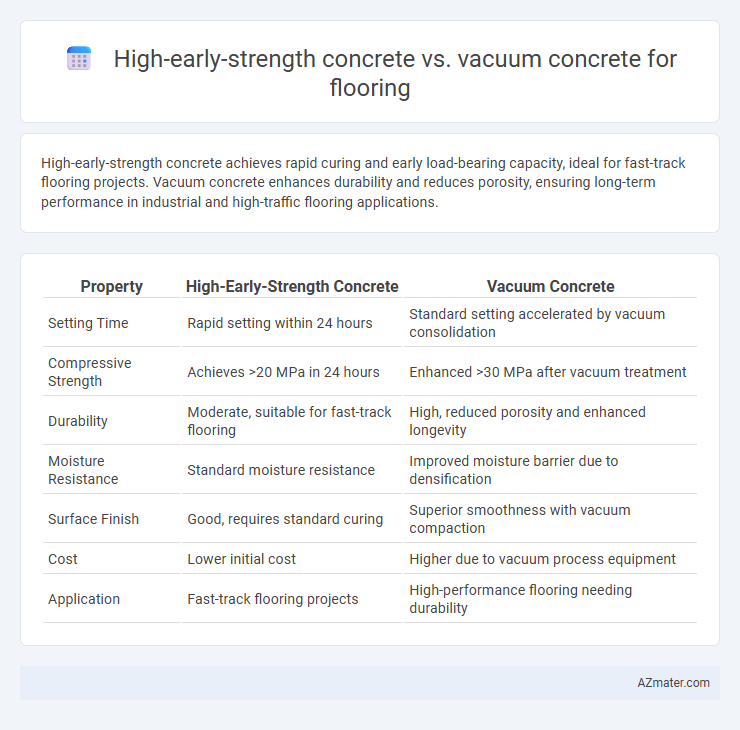High-early-strength concrete achieves rapid curing and early load-bearing capacity, ideal for fast-track flooring projects. Vacuum concrete enhances durability and reduces porosity, ensuring long-term performance in industrial and high-traffic flooring applications.
Table of Comparison
| Property | High-Early-Strength Concrete | Vacuum Concrete |
|---|---|---|
| Setting Time | Rapid setting within 24 hours | Standard setting accelerated by vacuum consolidation |
| Compressive Strength | Achieves >20 MPa in 24 hours | Enhanced >30 MPa after vacuum treatment |
| Durability | Moderate, suitable for fast-track flooring | High, reduced porosity and enhanced longevity |
| Moisture Resistance | Standard moisture resistance | Improved moisture barrier due to densification |
| Surface Finish | Good, requires standard curing | Superior smoothness with vacuum compaction |
| Cost | Lower initial cost | Higher due to vacuum process equipment |
| Application | Fast-track flooring projects | High-performance flooring needing durability |
Introduction to Concrete Flooring Technologies
High-early-strength concrete achieves rapid strength gain, making it ideal for fast-track flooring projects where early load-bearing capacity is essential. Vacuum concrete utilizes vacuum dewatering technology to remove excess water, resulting in a denser, stronger, and more durable floor surface with reduced drying times. Both technologies enhance construction efficiency but differ in application, with high-early-strength concrete prioritizing early curing strength and vacuum concrete focusing on microstructural integrity and long-term performance.
What is High-Early-Strength Concrete?
High-early-strength concrete is a specialized mix designed to achieve rapid strength gain within hours, reaching 70% to 90% of its design strength in just one to three days. This concrete type is ideal for flooring applications requiring quick turnaround times, supporting early load bearing and reducing downtime. Vacuum concrete, by contrast, uses vacuum dewatering to improve density and strength but typically gains strength at a standard rate compared to the accelerated curing of high-early-strength concrete.
Understanding Vacuum Concrete
Vacuum concrete improves flooring performance by removing excess water through a vacuum system, resulting in higher density and increased durability compared to conventional high-early-strength concrete. This method enhances compressive strength and reduces permeability, making it ideal for industrial floors subjected to heavy loads and chemical exposure. Understanding vacuum concrete technology enables better decision-making for flooring applications requiring superior wear resistance and longevity.
Key Differences in Composition
High-early-strength concrete contains a higher proportion of cement and specialized additives such as calcium sulfoaluminate, accelerating the hydration process to achieve rapid strength gain within 24 hours. Vacuum concrete incorporates a vacuum dewatering process that removes excess water from the mix, resulting in a denser microstructure with reduced porosity and enhanced durability. The primary compositional difference lies in the admixtures and processing techniques, with high-early-strength concrete focusing on chemical acceleration while vacuum concrete emphasizes mechanical water removal for optimized floor performance.
Strength Development and Setting Times
High-early-strength concrete achieves rapid strength gain, often reaching 70% of its ultimate strength within 24 hours, making it ideal for fast-track flooring projects requiring early load application. Vacuum concrete, enhanced by vacuum dewatering, improves density and strength by removing excess water, leading to reduced porosity and higher long-term compressive strength, but it typically has longer setting times compared to high-early-strength mixes. Selecting between the two depends on project timelines and the balance between immediate strength requirements and long-term durability for flooring applications.
Surface Finish and Durability Comparison
High-early-strength concrete achieves rapid curing, delivering a dense and smooth surface finish ideal for fast-track flooring projects where early load application is critical. Vacuum concrete incorporates a vacuum dewatering process that removes excess water, resulting in a highly compacted, durable surface with superior wear resistance and reduced shrinkage cracks. While high-early-strength concrete excels in quick strength gain, vacuum concrete offers enhanced long-term durability and a more refined surface texture suitable for heavy-traffic flooring applications.
Suitability for Heavy-Duty Flooring Applications
High-early-strength concrete achieves rapid strength gain suitable for fast-track construction but may exhibit higher shrinkage risks under heavy loads. Vacuum concrete, utilizing suction to remove excess water, enhances density and durability, making it more resilient to heavy-duty flooring stresses like impact and abrasion. For industrial flooring requiring exceptional load-bearing capacity and longevity, vacuum concrete provides superior performance compared to high-early-strength alternatives.
Construction Speed and Efficiency
High-early-strength concrete accelerates construction speed by reaching design strength within 24 hours, enabling faster floor installation and reduced curing time. Vacuum concrete enhances efficiency by removing entrapped air and excess water, resulting in higher density, improved durability, and lower shrinkage, which reduces the need for repairs. In flooring applications, combining rapid strength gain with superior material quality optimizes overall project timelines and long-term performance.
Cost Implications and Material Availability
High-early-strength concrete offers faster curing times, reducing labor costs and project timelines, but typically requires specialized cement blends that may be costlier and less readily available in some regions. Vacuum concrete, used to improve density and durability through air removal, involves additional equipment and processing expenses, which can increase overall costs despite potential long-term savings from enhanced performance. Material availability for high-early-strength concrete is generally broader due to more common use in rapid construction, whereas vacuum concrete relies on niche technology and may face limitations depending on local supply chains and technical expertise.
Choosing the Right Concrete for Your Flooring Project
High-early-strength concrete offers rapid strength gain, reducing floor application time and enabling faster project turnover, making it ideal for tight schedules and commercial environments requiring quick load-bearing capacity. Vacuum concrete, enhanced through vacuum dewatering, achieves lower water-cement ratios and significantly improved density, resulting in higher durability and superior surface finish, perfect for heavy-duty industrial flooring and areas exposed to harsh wear. Selecting the right concrete depends on project timeline, load demands, and durability requirements, ensuring optimal performance and longevity of the flooring system.

Infographic: High-early-strength concrete vs Vacuum concrete for Flooring
 azmater.com
azmater.com